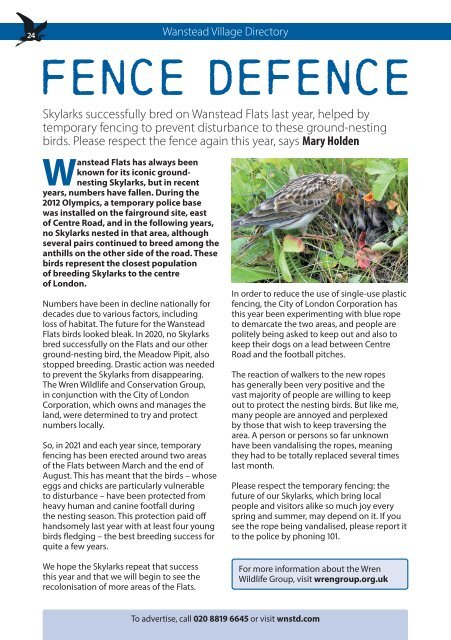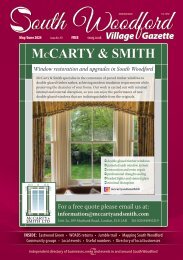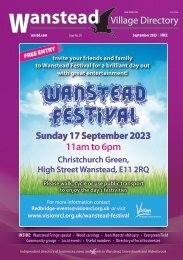You also want an ePaper? Increase the reach of your titles
YUMPU automatically turns print PDFs into web optimized ePapers that Google loves.
24<br />
Wanstead Village Directory<br />
Fence defence<br />
Skylarks successfully bred on Wanstead Flats last year, helped by<br />
temporary fencing to prevent disturbance to these ground-nesting<br />
birds. Please respect the fence again this year, says Mary Holden<br />
Wanstead Flats has always been<br />
known for its iconic groundnesting<br />
Skylarks, but in recent<br />
years, numbers have fallen. During the<br />
2012 Olympics, a temporary police base<br />
was installed on the fairground site, east<br />
of Centre Road, and in the following years,<br />
no Skylarks nested in that area, although<br />
several pairs continued to breed among the<br />
anthills on the other side of the road. These<br />
birds represent the closest population<br />
of breeding Skylarks to the centre<br />
of London.<br />
Numbers have been in decline nationally for<br />
decades due to various factors, including<br />
loss of habitat. The future for the Wanstead<br />
Flats birds looked bleak. In 2020, no Skylarks<br />
bred successfully on the Flats and our other<br />
ground-nesting bird, the Meadow Pipit, also<br />
stopped breeding. Drastic action was needed<br />
to prevent the Skylarks from disappearing.<br />
The Wren Wildlife and Conservation Group,<br />
in conjunction with the City of London<br />
Corporation, which owns and manages the<br />
land, were determined to try and protect<br />
numbers locally.<br />
So, in 2021 and each year since, temporary<br />
fencing has been erected around two areas<br />
of the Flats between March and the end of<br />
August. This has meant that the birds – whose<br />
eggs and chicks are particularly vulnerable<br />
to disturbance – have been protected from<br />
heavy human and canine footfall during<br />
the nesting season. This protection paid off<br />
handsomely last year with at least four young<br />
birds fledging – the best breeding success for<br />
quite a few years.<br />
We hope the Skylarks repeat that success<br />
this year and that we will begin to see the<br />
recolonisation of more areas of the Flats.<br />
In order to reduce the use of single-use plastic<br />
fencing, the City of London Corporation has<br />
this year been experimenting with blue rope<br />
to demarcate the two areas, and people are<br />
politely being asked to keep out and also to<br />
keep their dogs on a lead between Centre<br />
Road and the football pitches.<br />
The reaction of walkers to the new ropes<br />
has generally been very positive and the<br />
vast majority of people are willing to keep<br />
out to protect the nesting birds. But like me,<br />
many people are annoyed and perplexed<br />
by those that wish to keep traversing the<br />
area. A person or persons so far unknown<br />
have been vandalising the ropes, meaning<br />
they had to be totally replaced several times<br />
last month.<br />
Please respect the temporary fencing: the<br />
future of our Skylarks, which bring local<br />
people and visitors alike so much joy every<br />
spring and summer, may depend on it. If you<br />
see the rope being vandalised, please report it<br />
to the police by phoning 101.<br />
For more information about the Wren<br />
Wildlife Group, visit wrengroup.org.uk<br />
To advertise, call 020 8819 6645 or visit wnstd.com
















